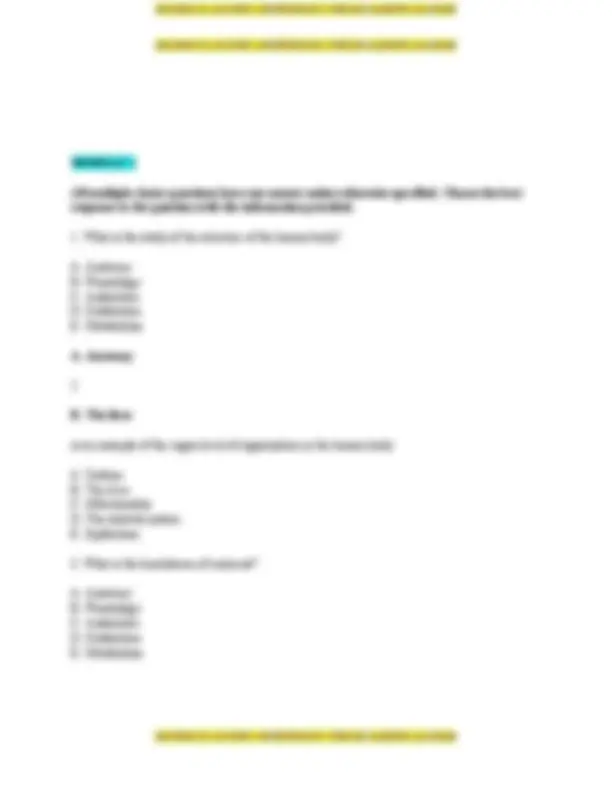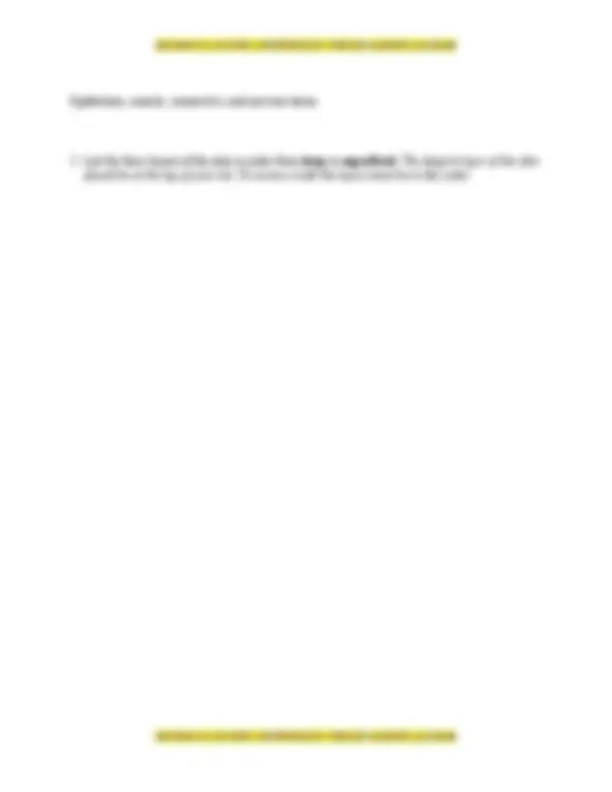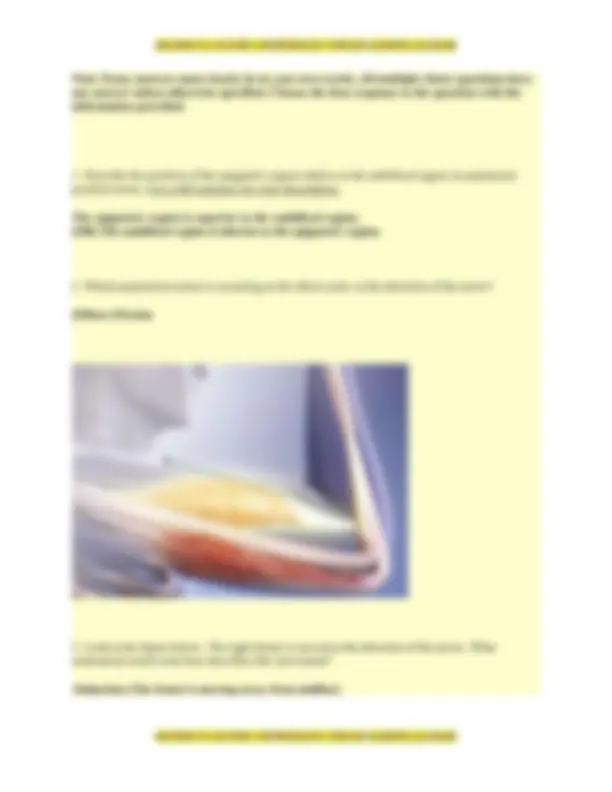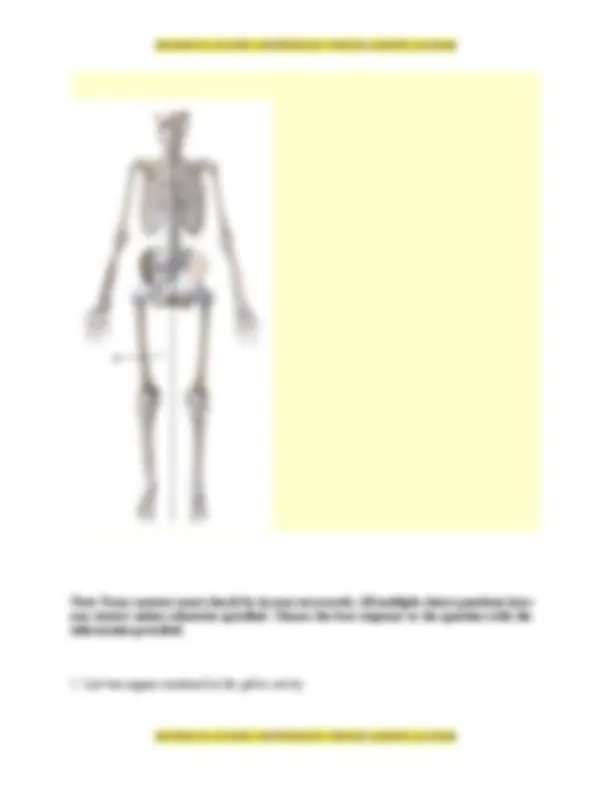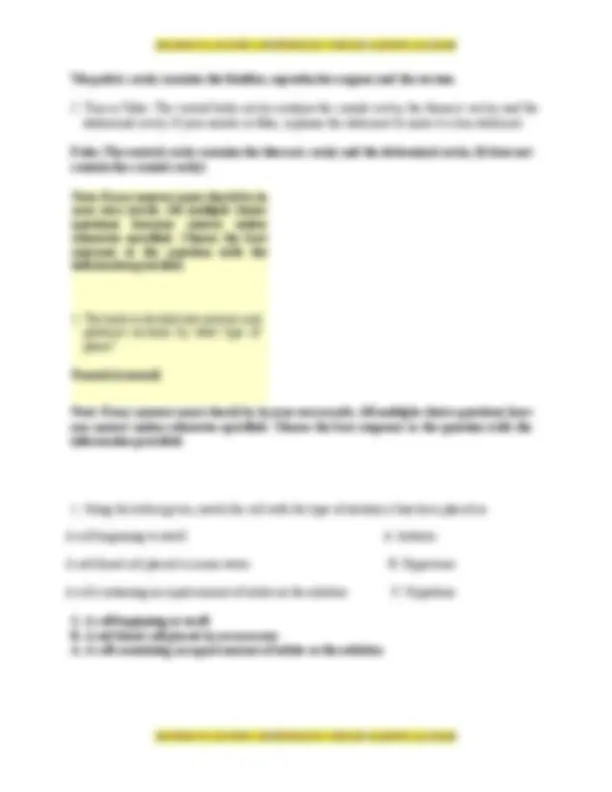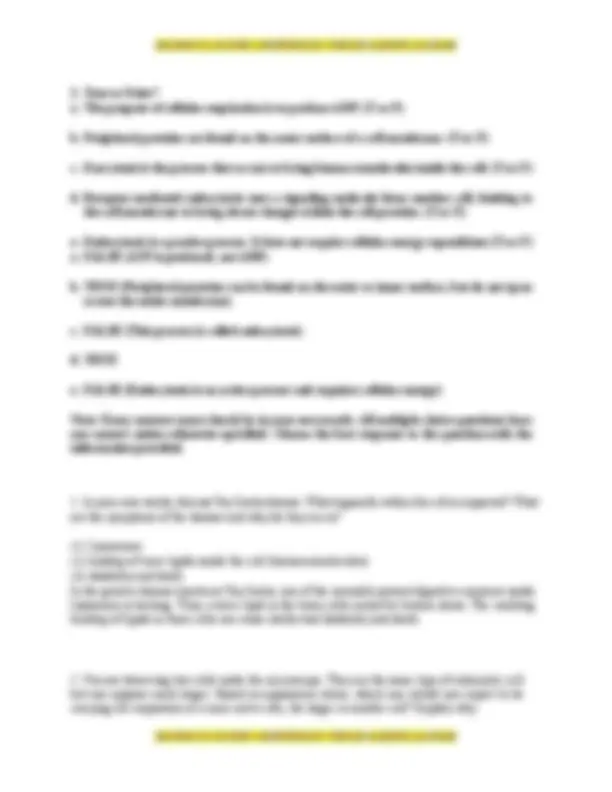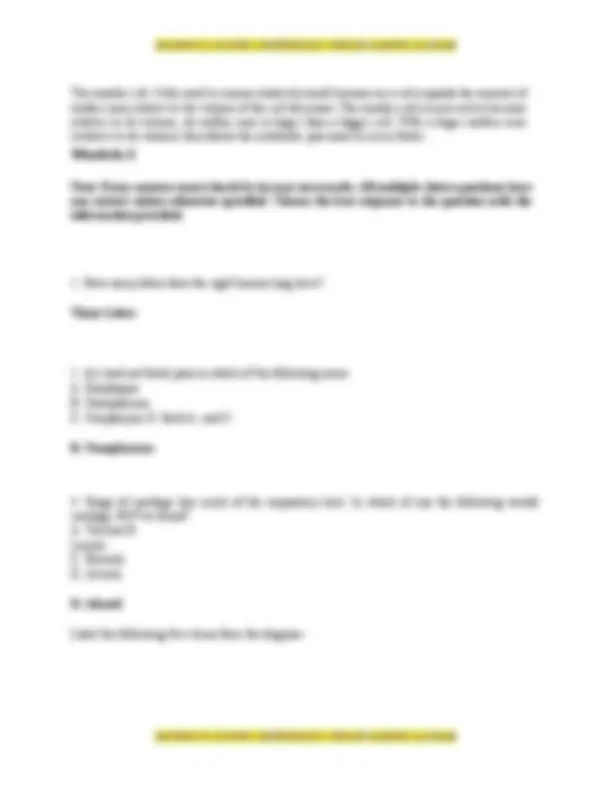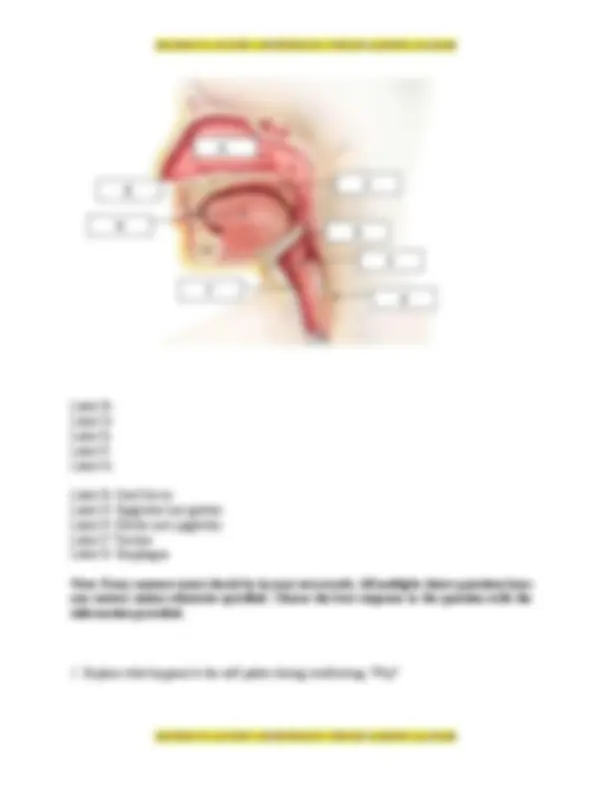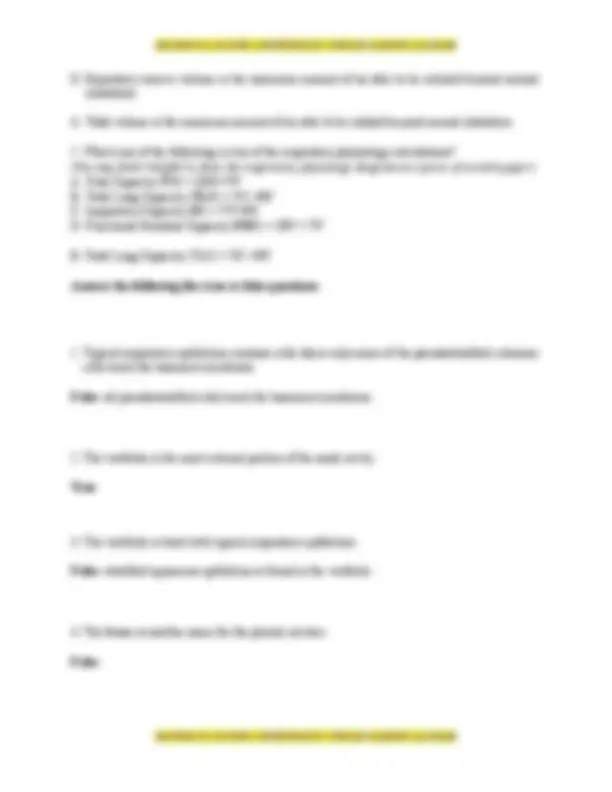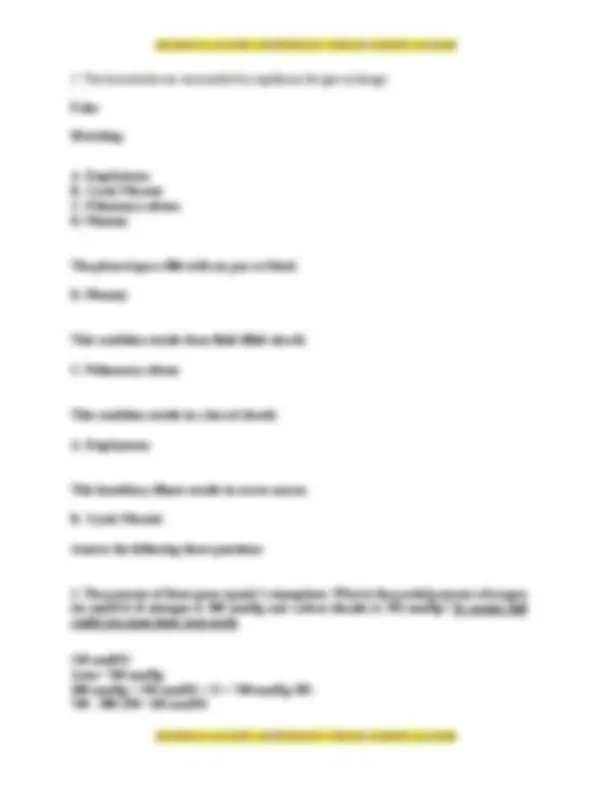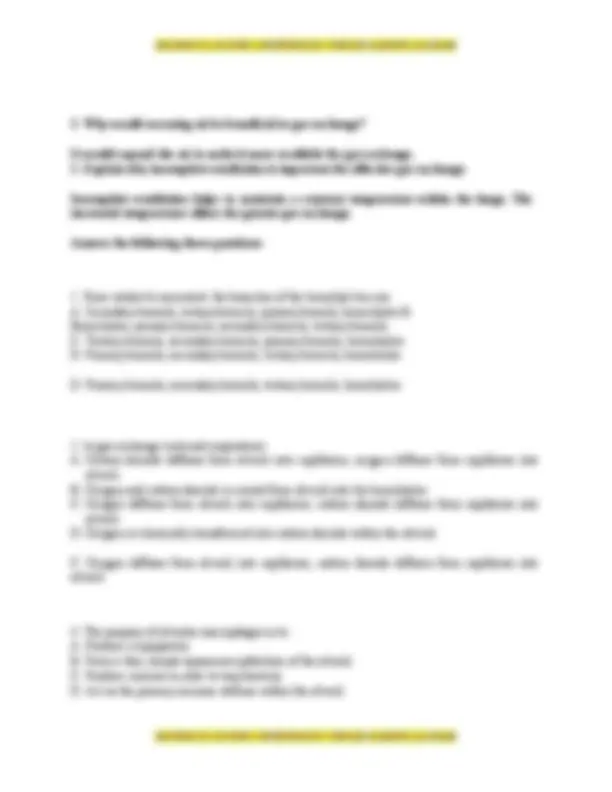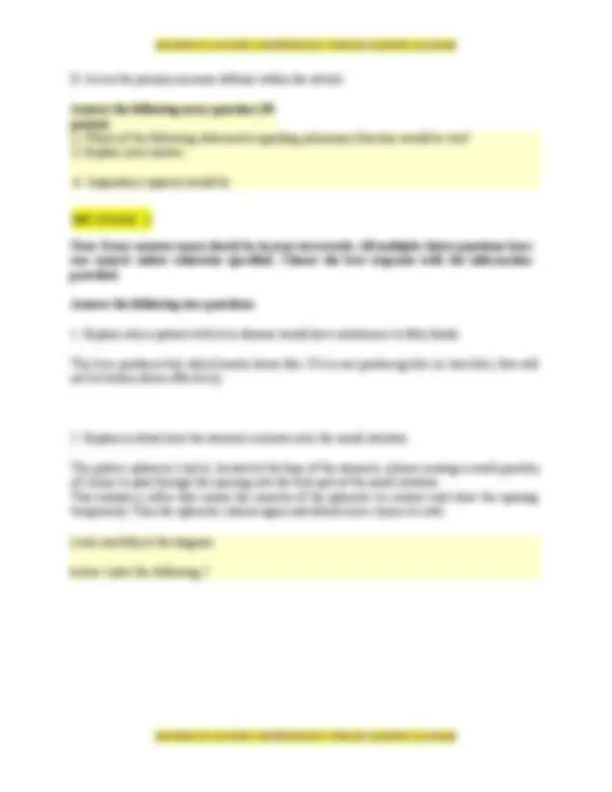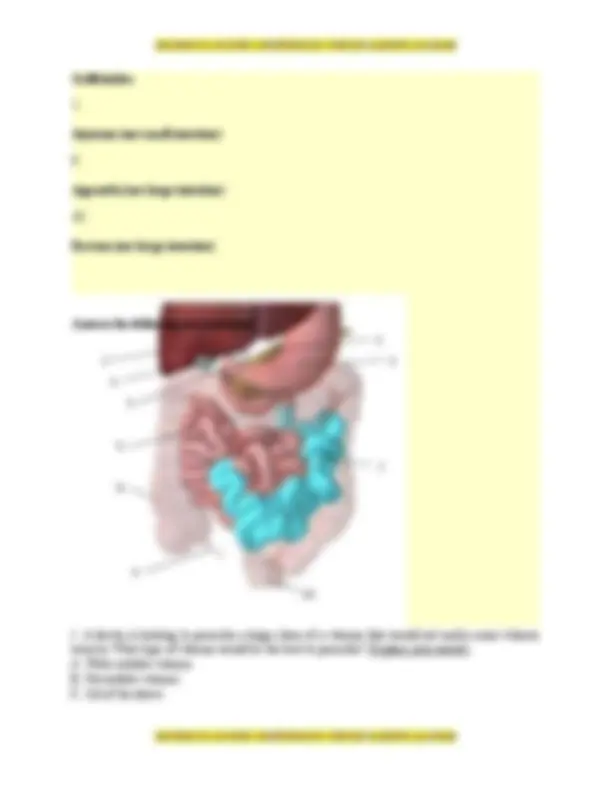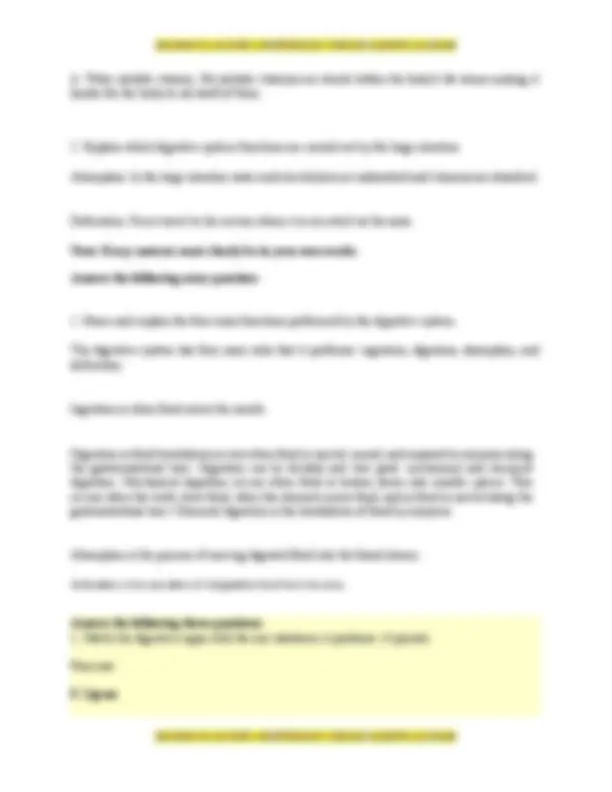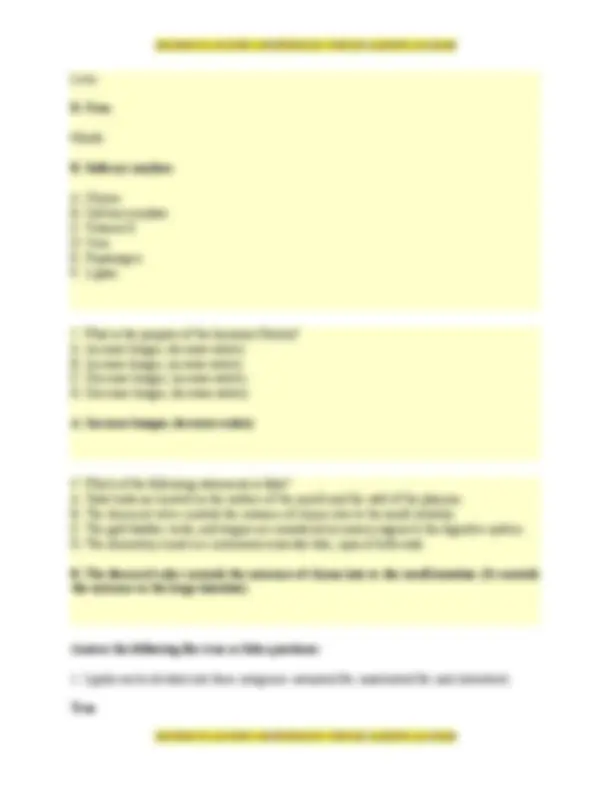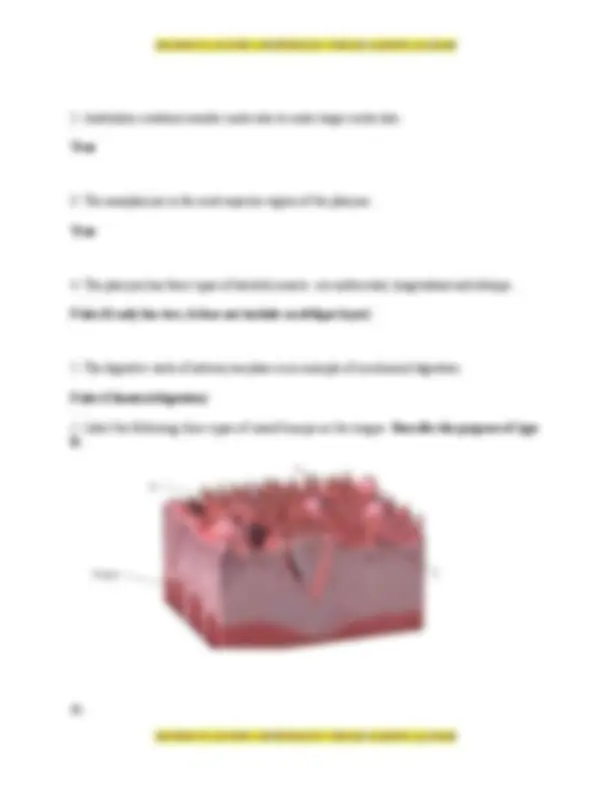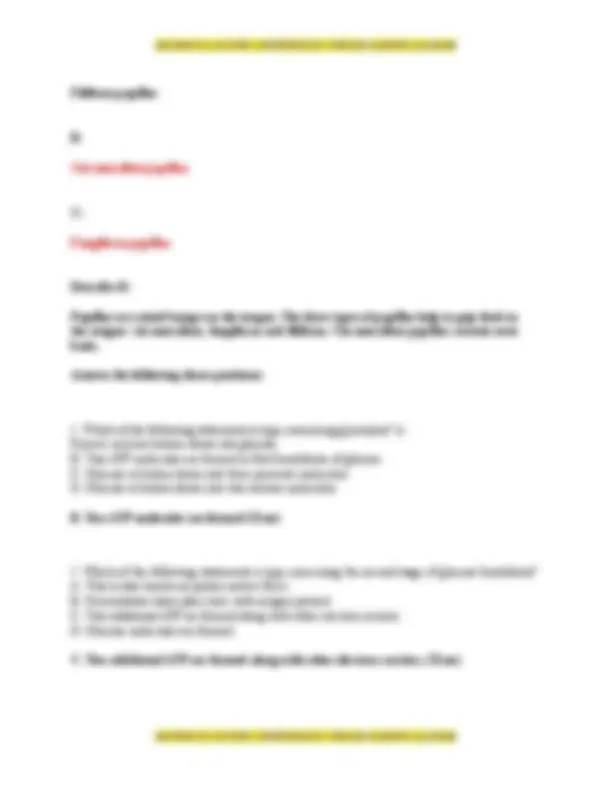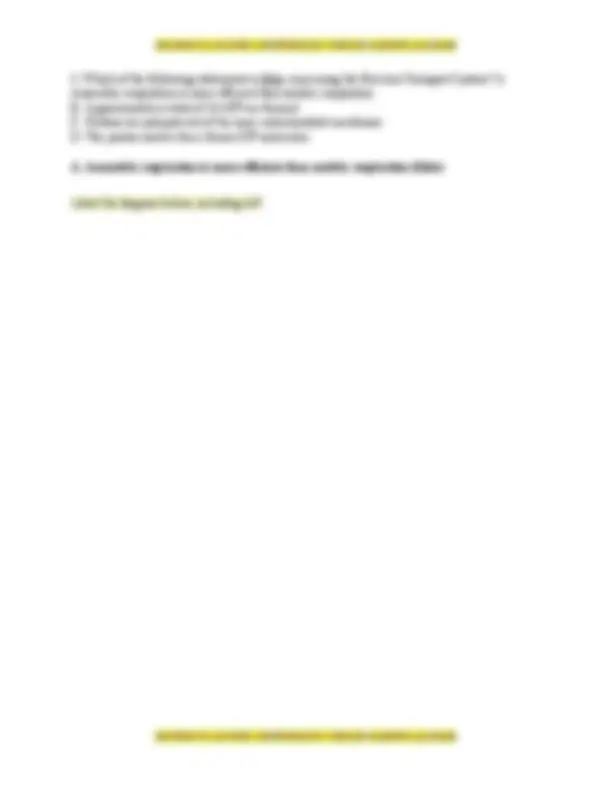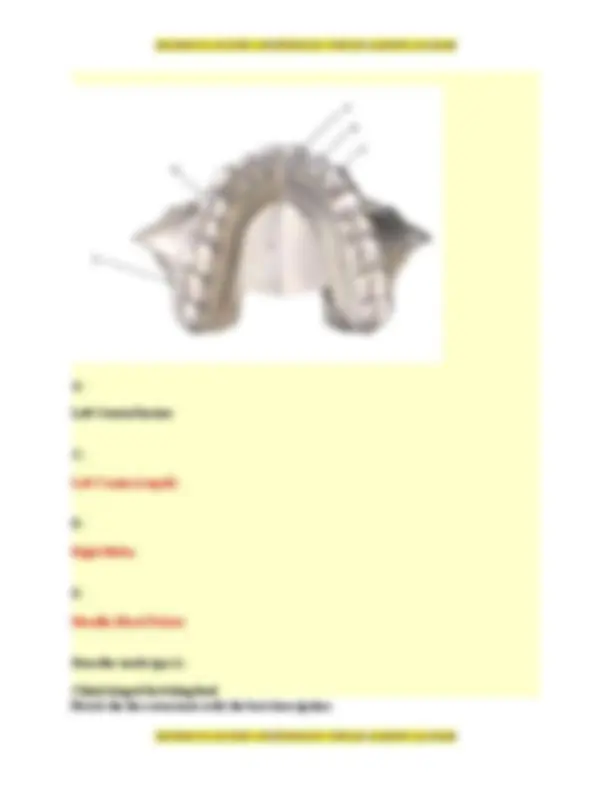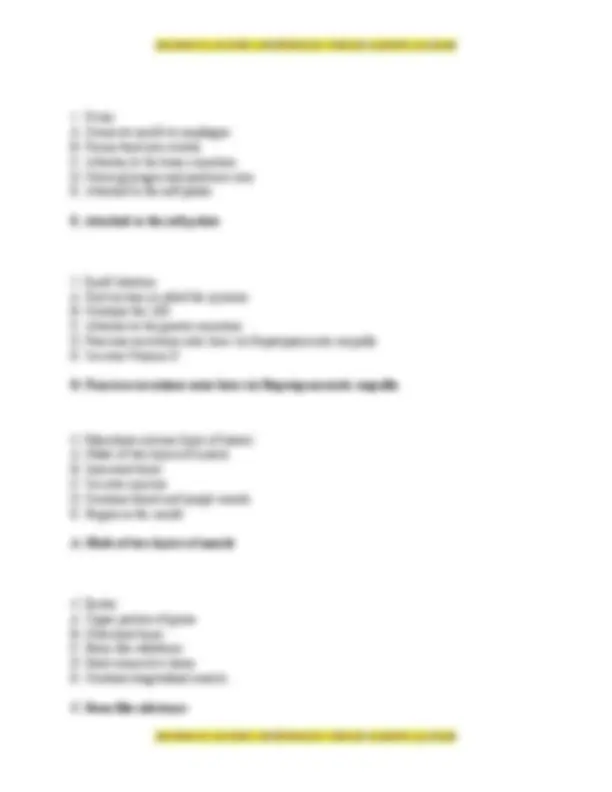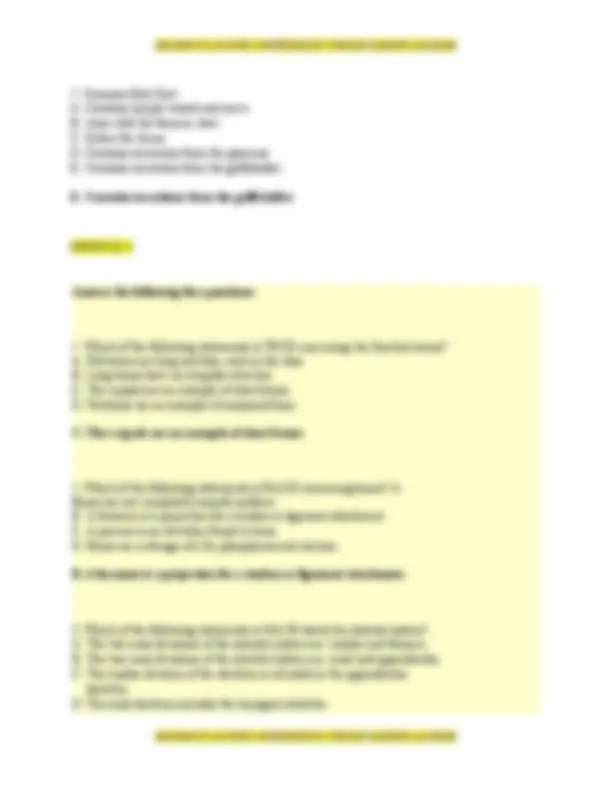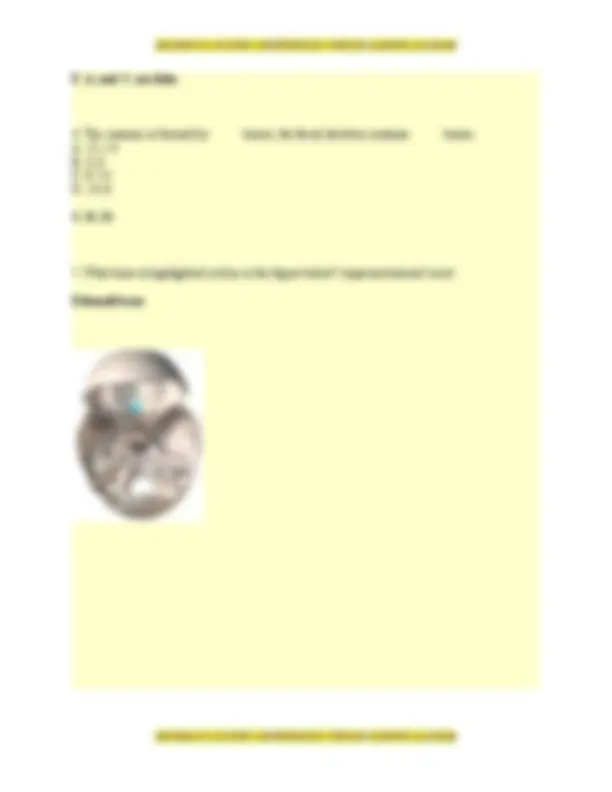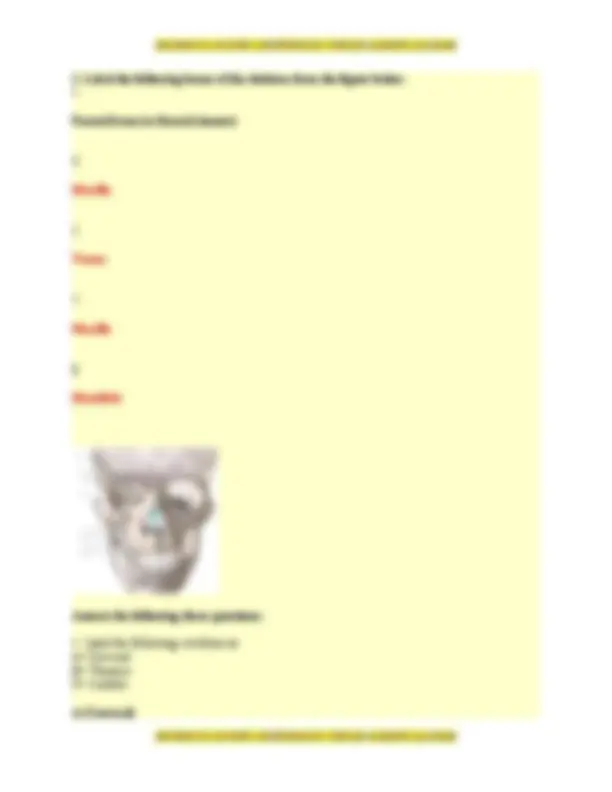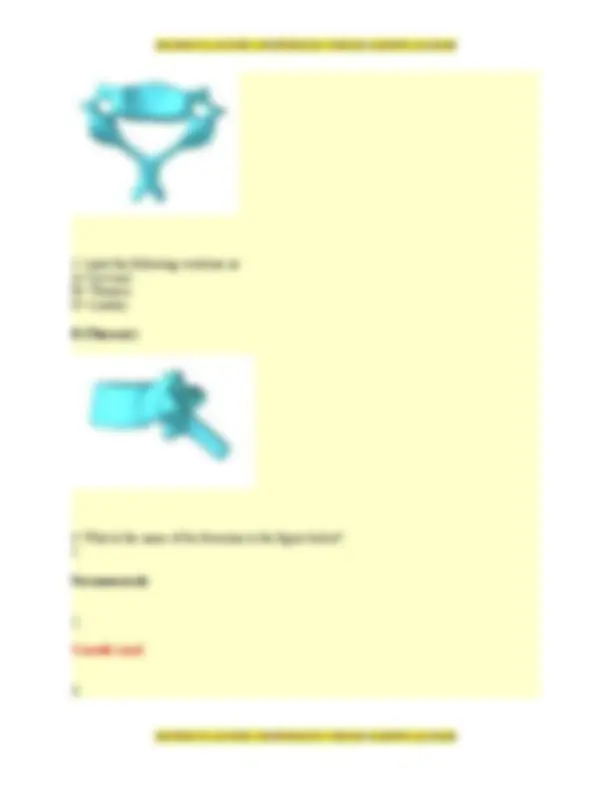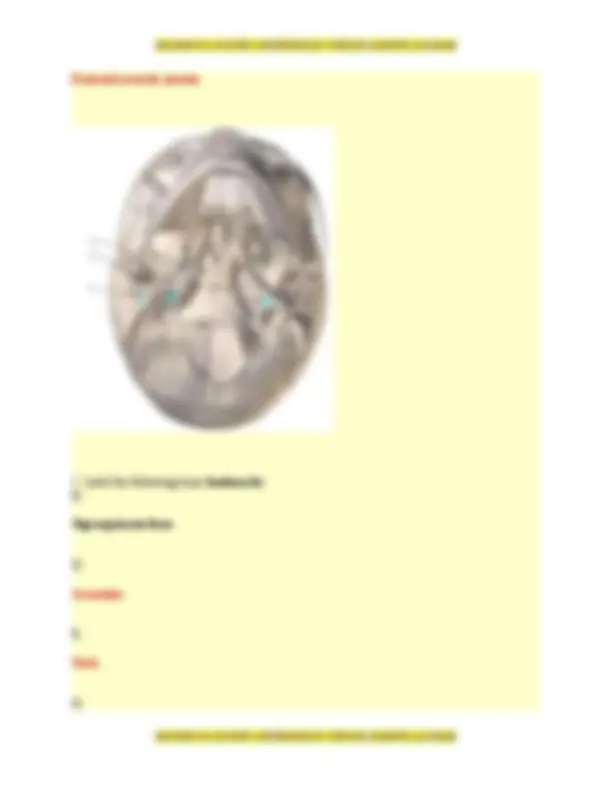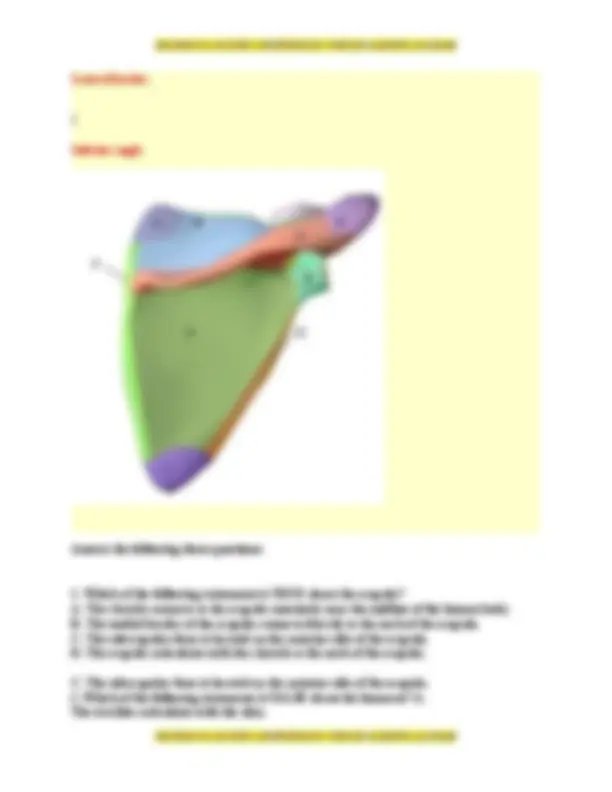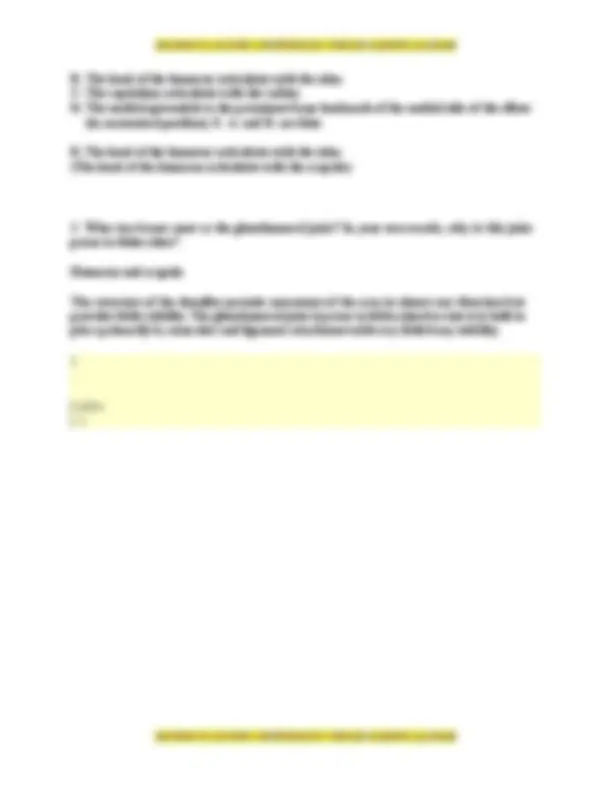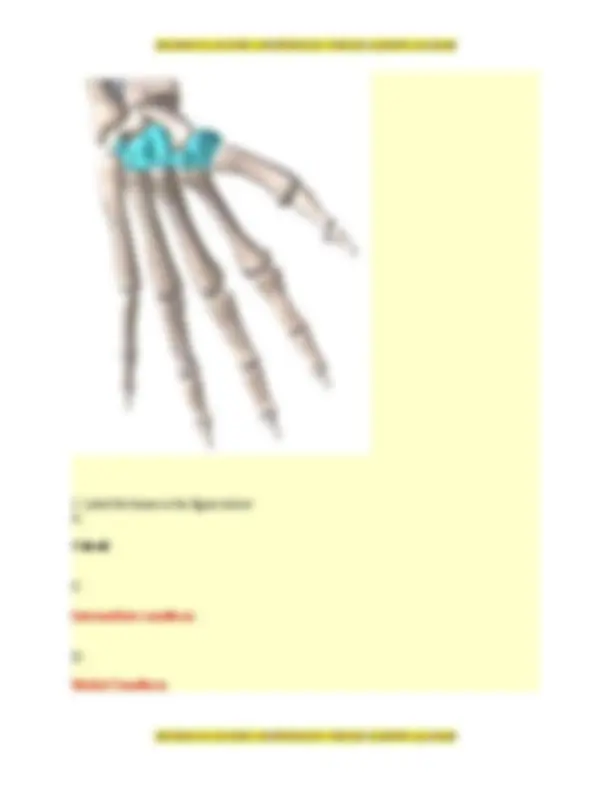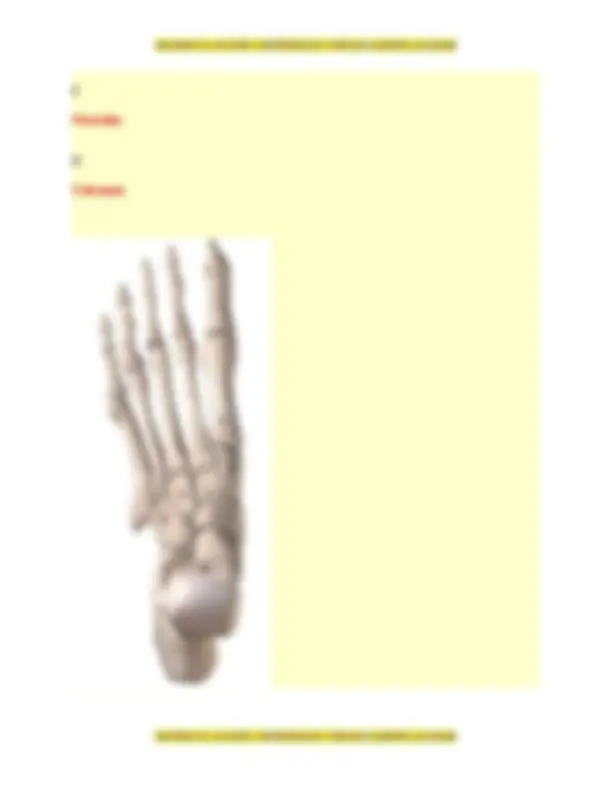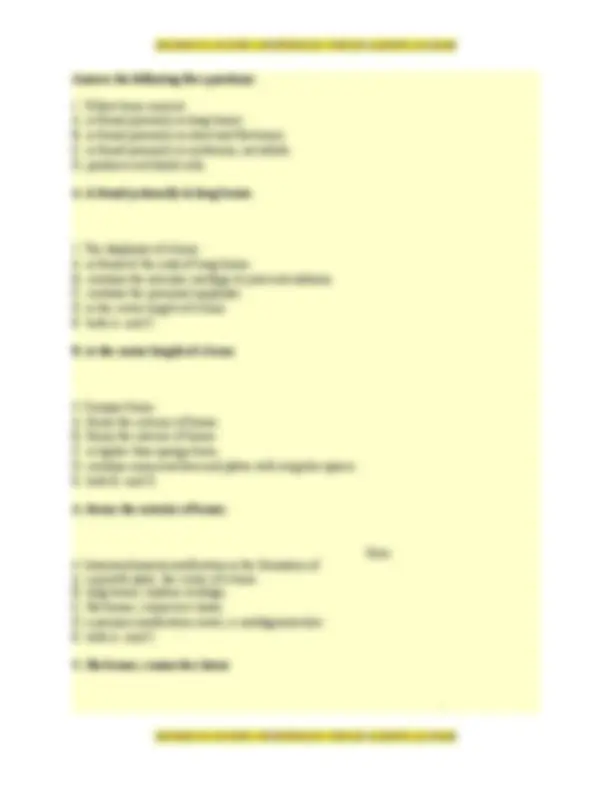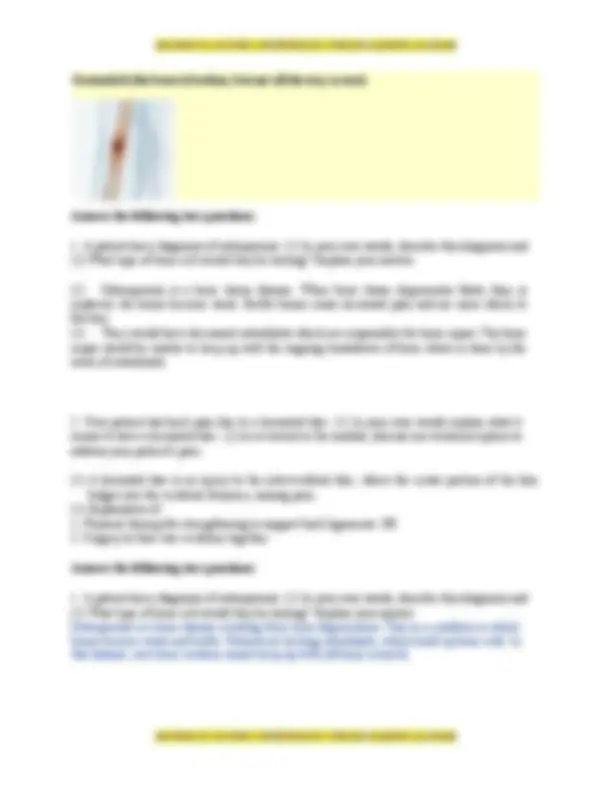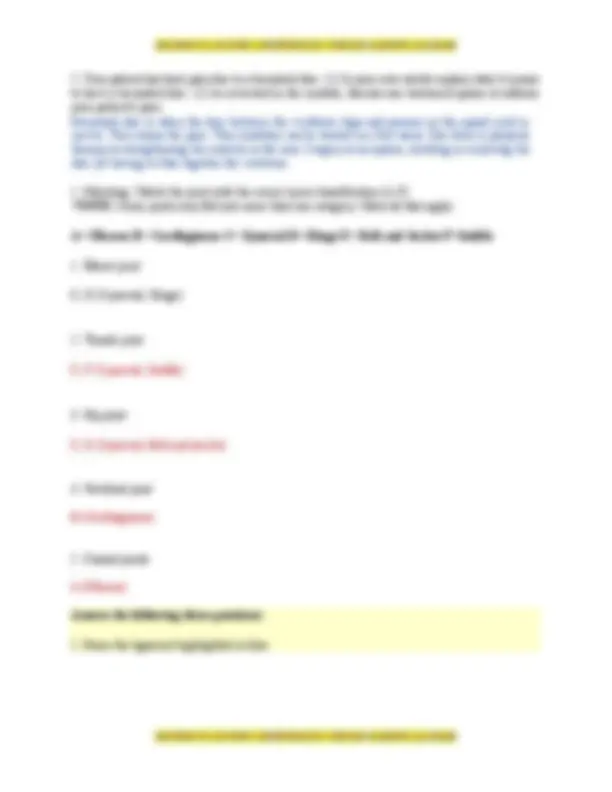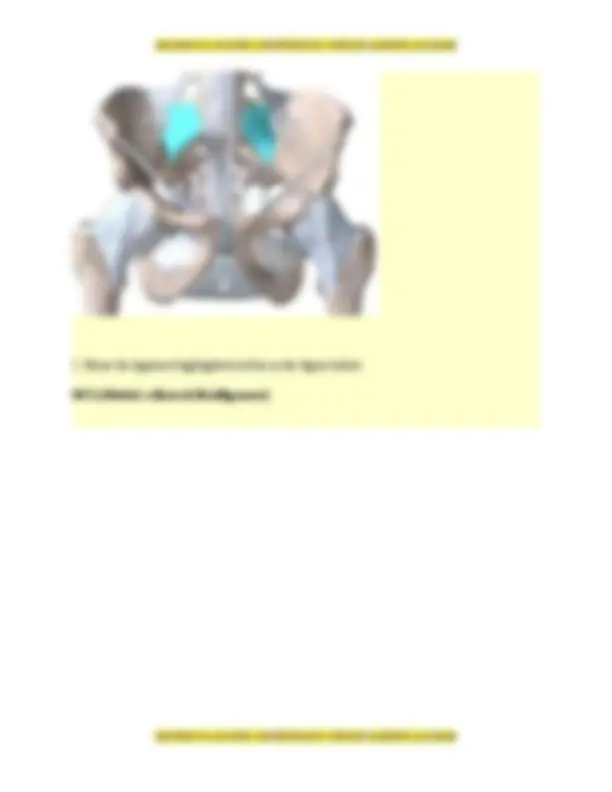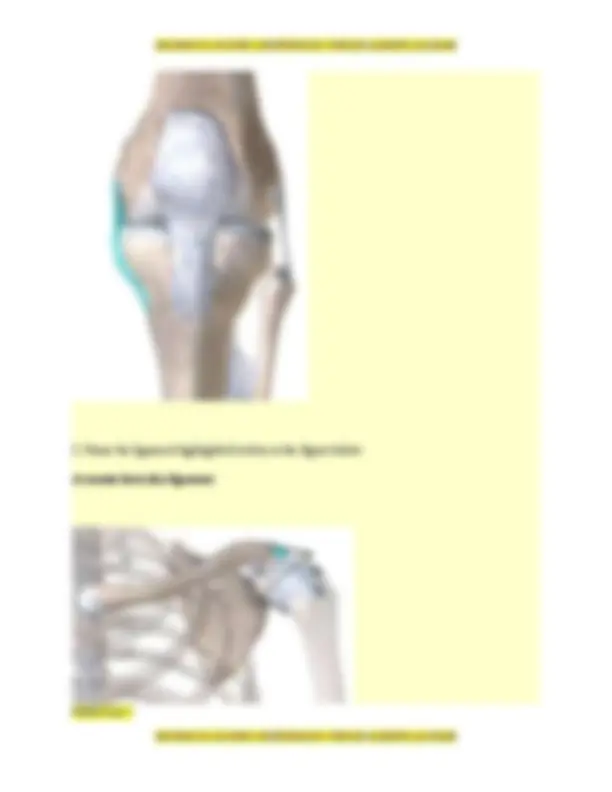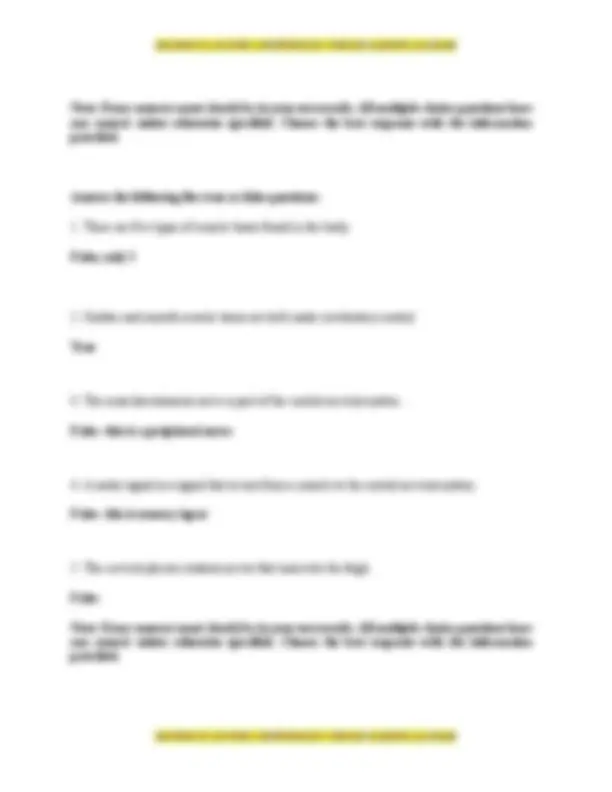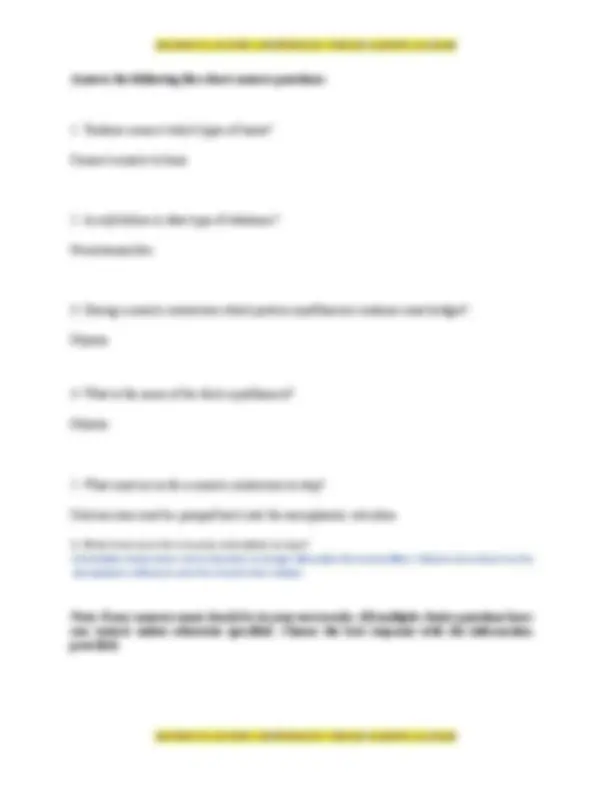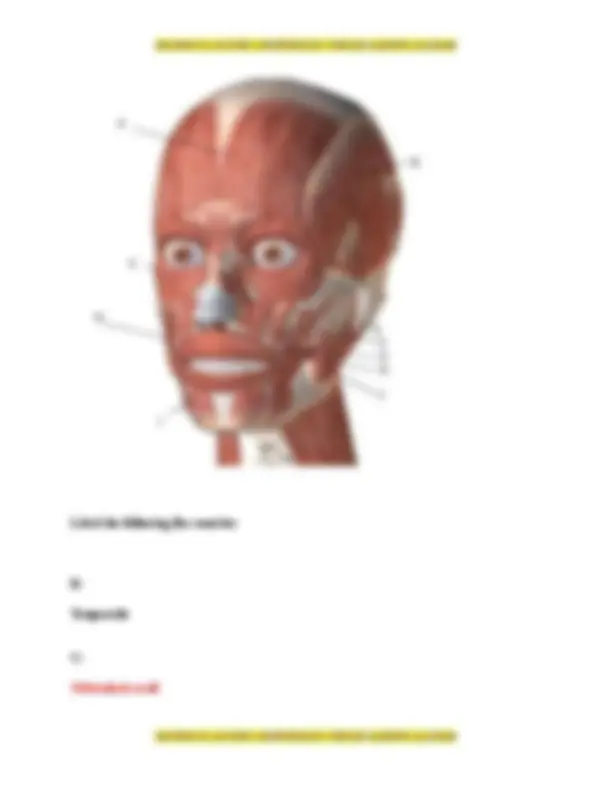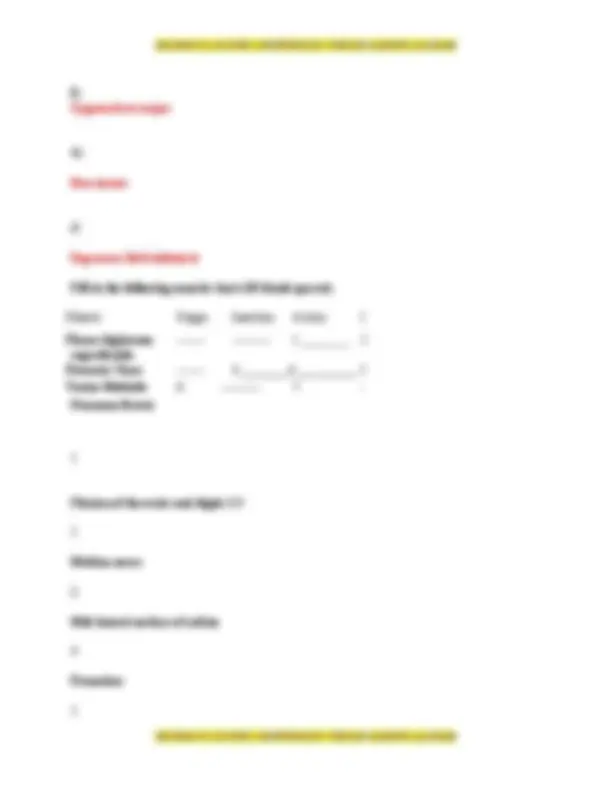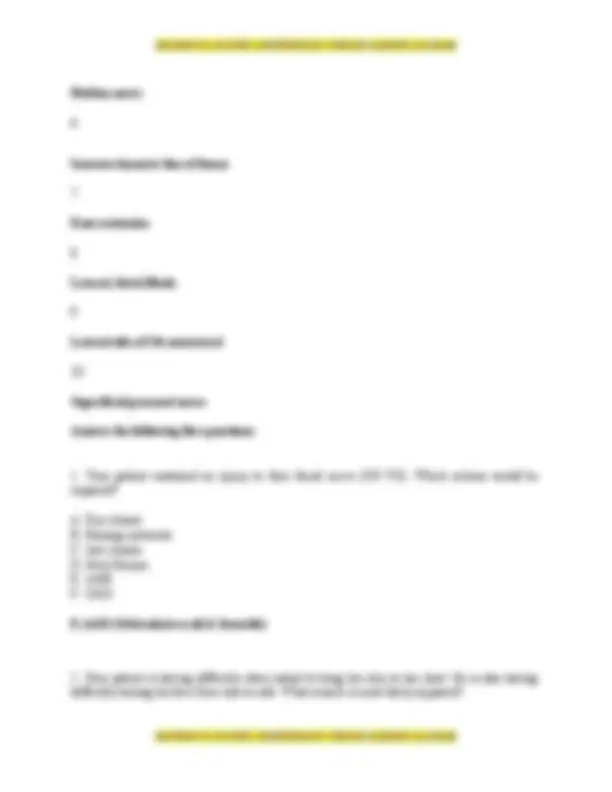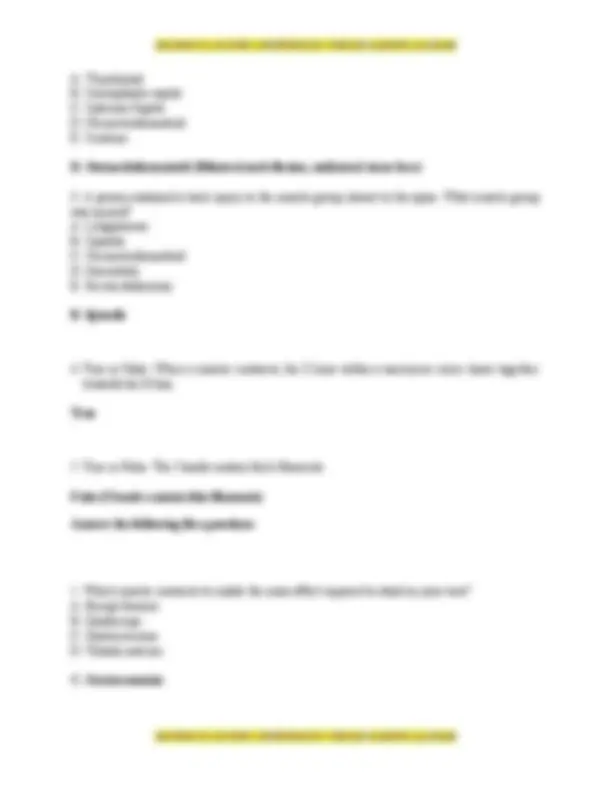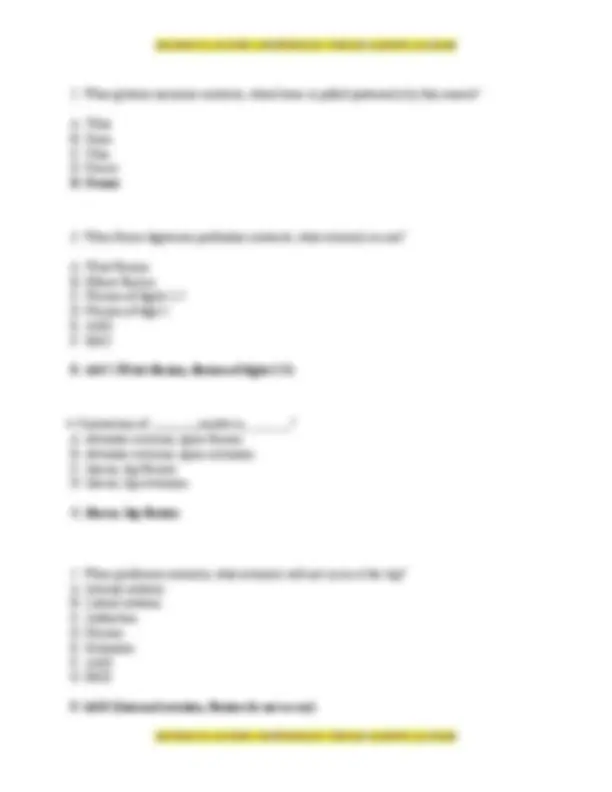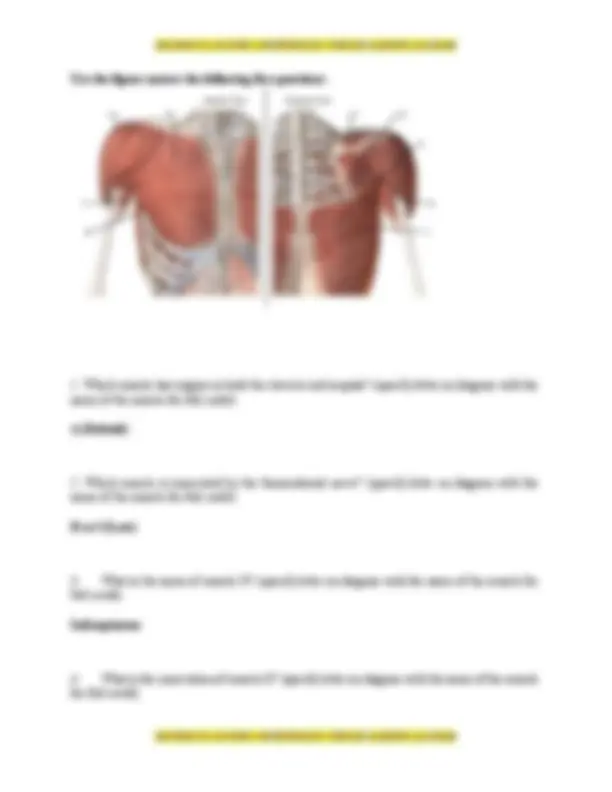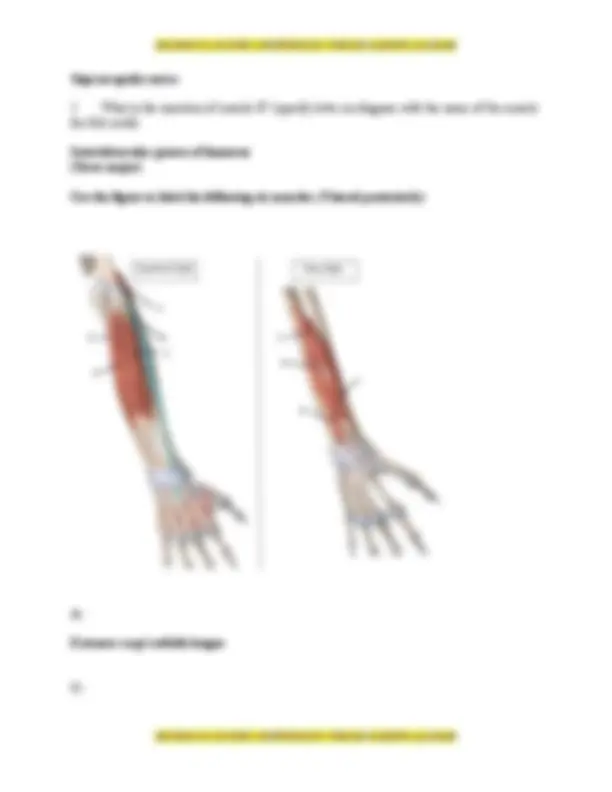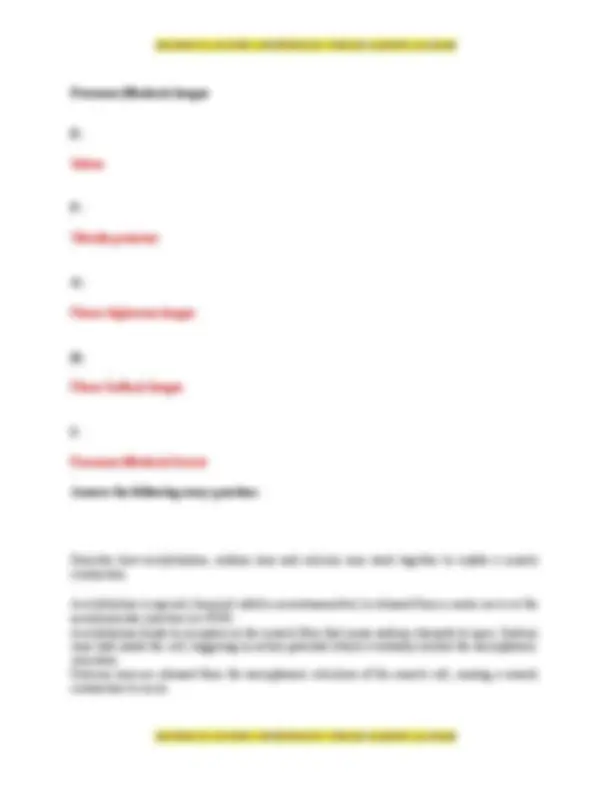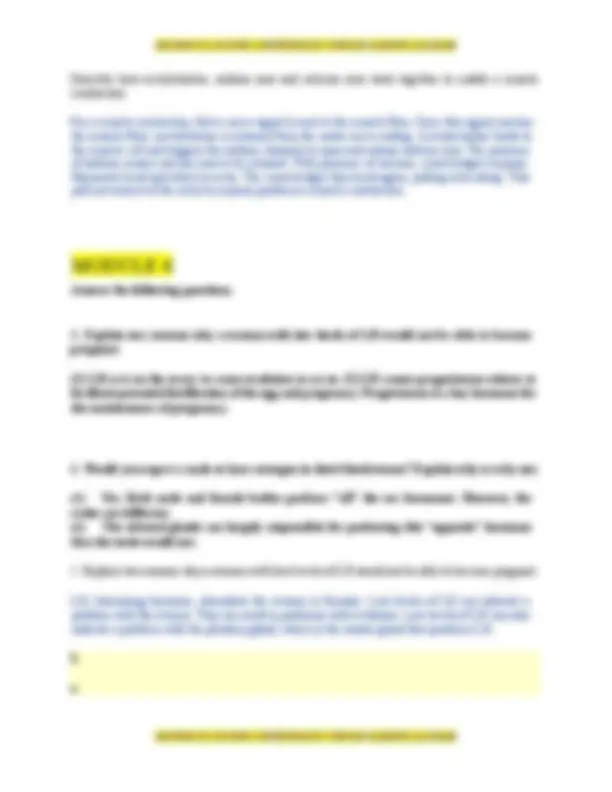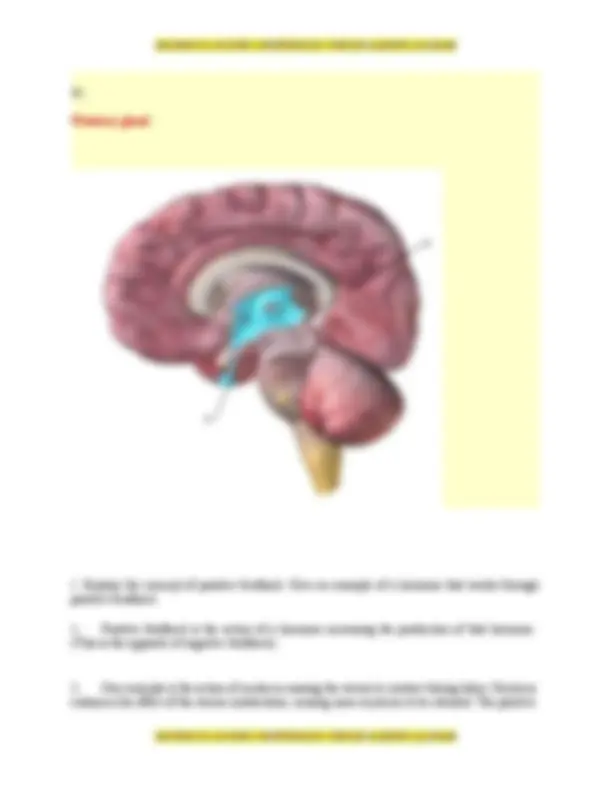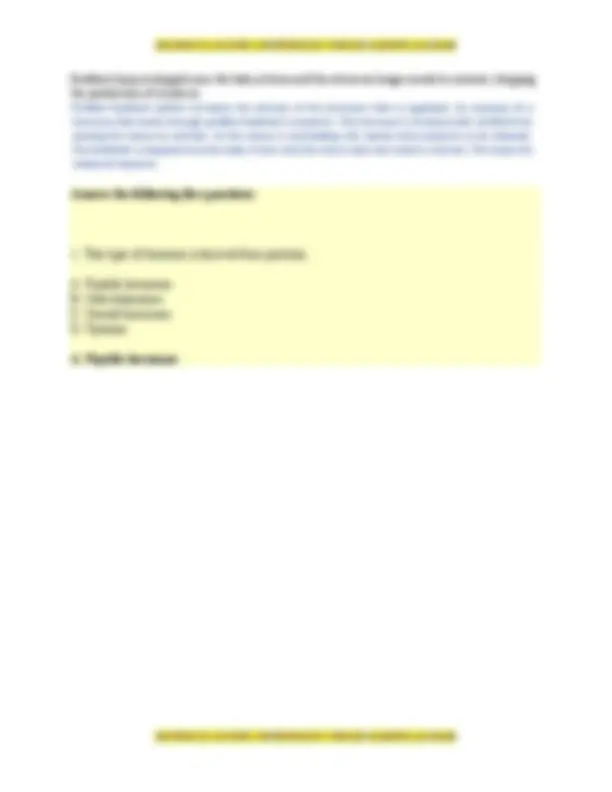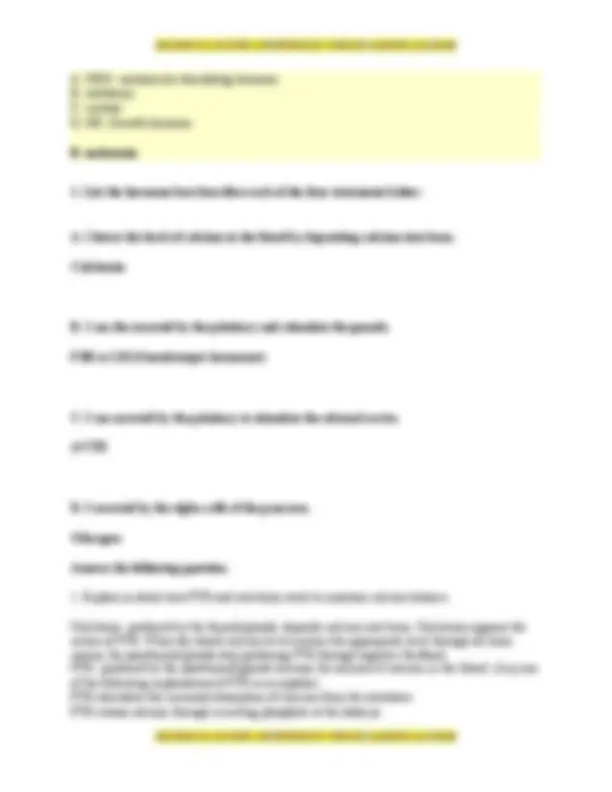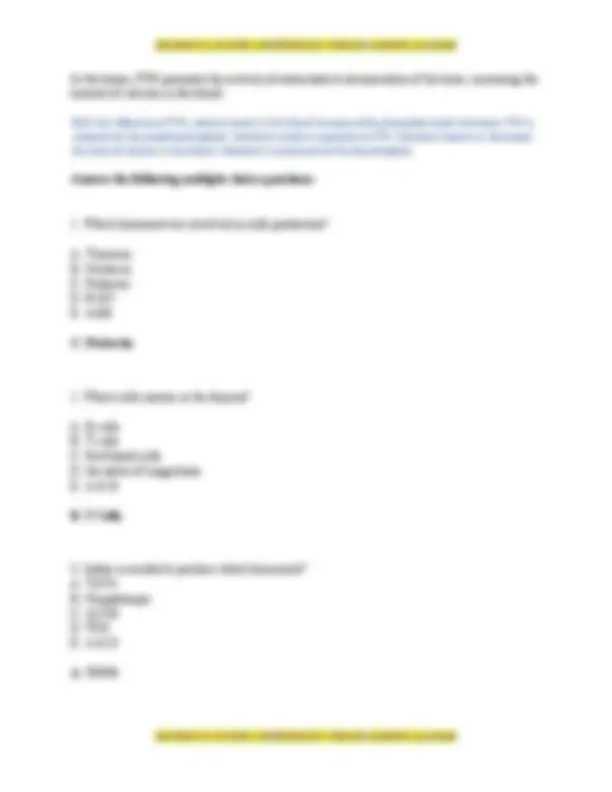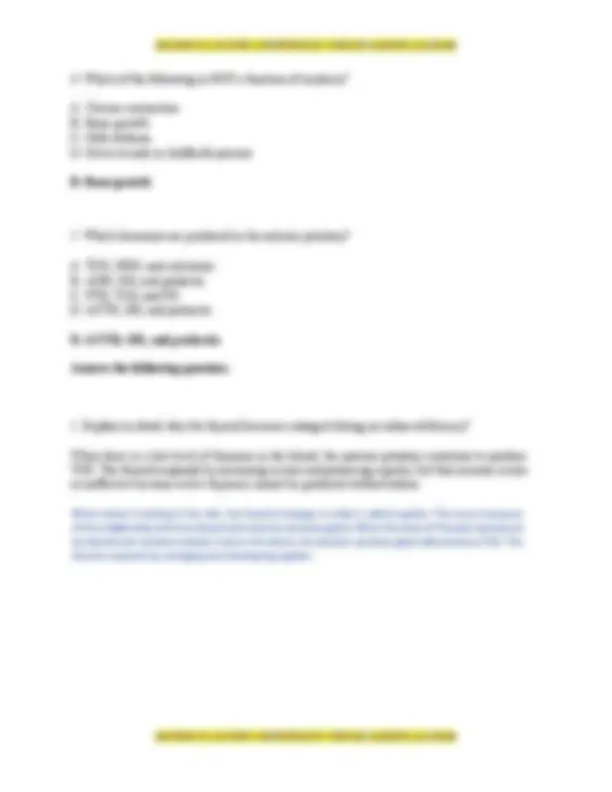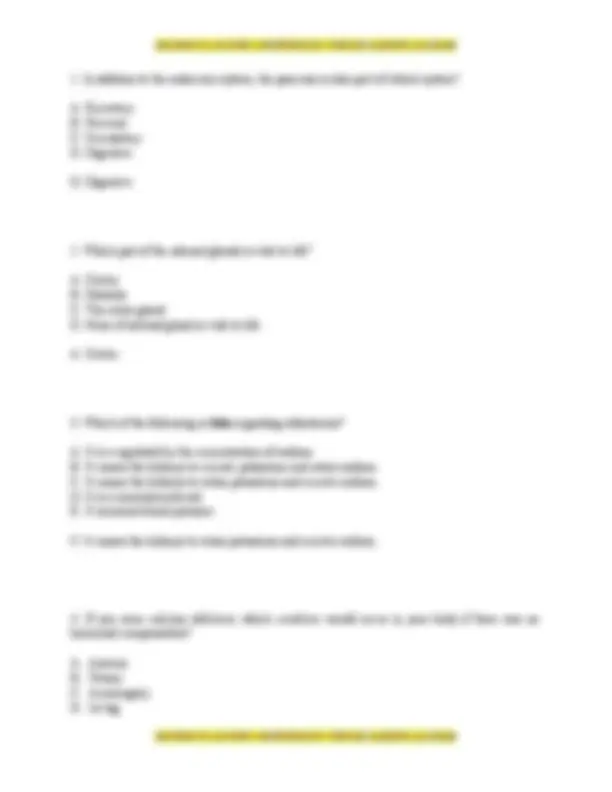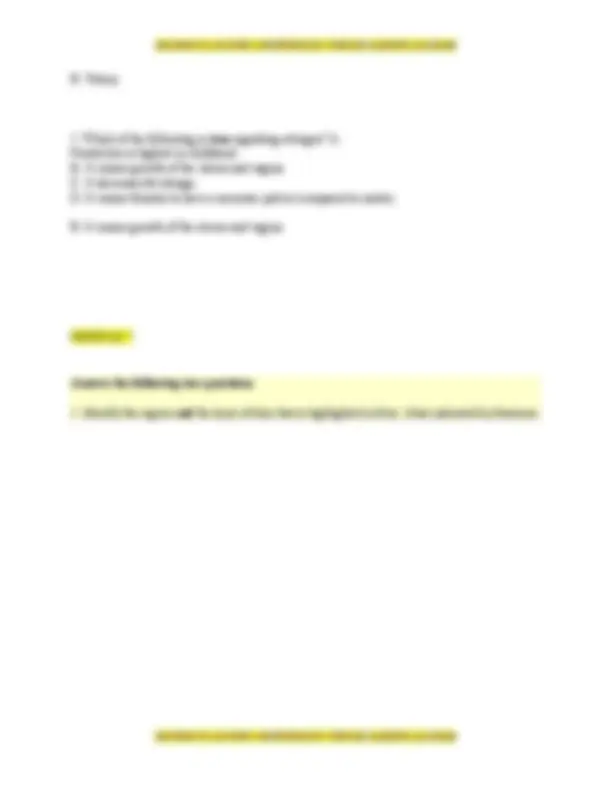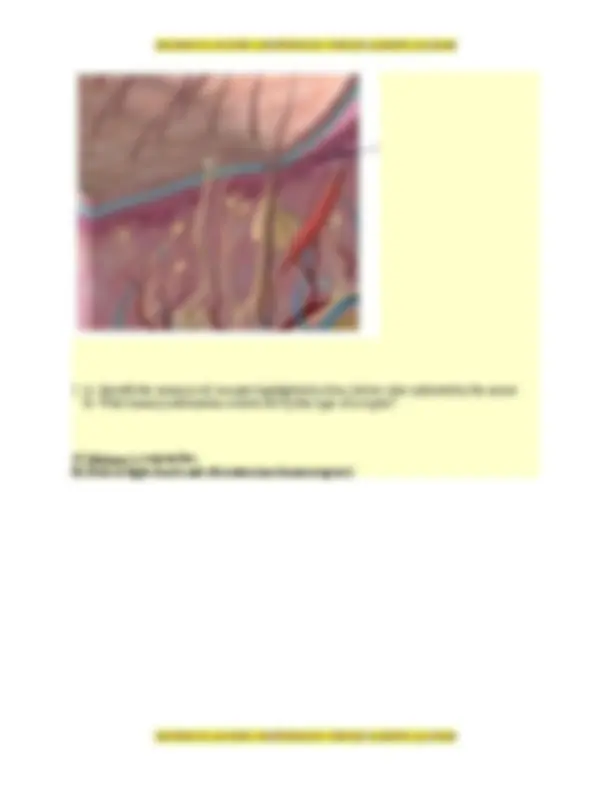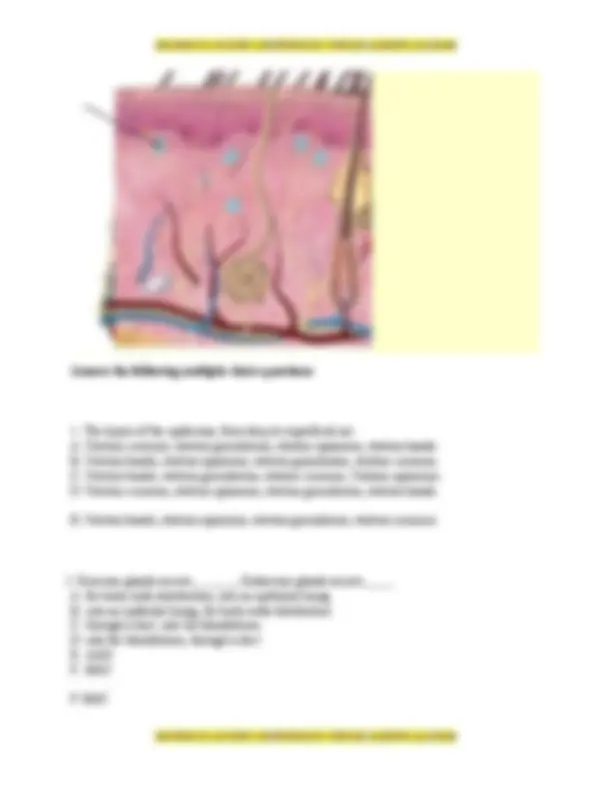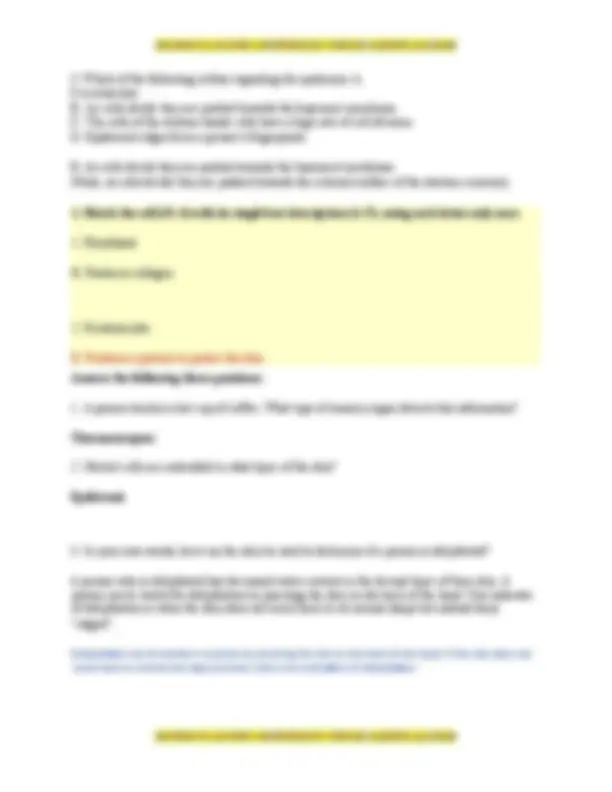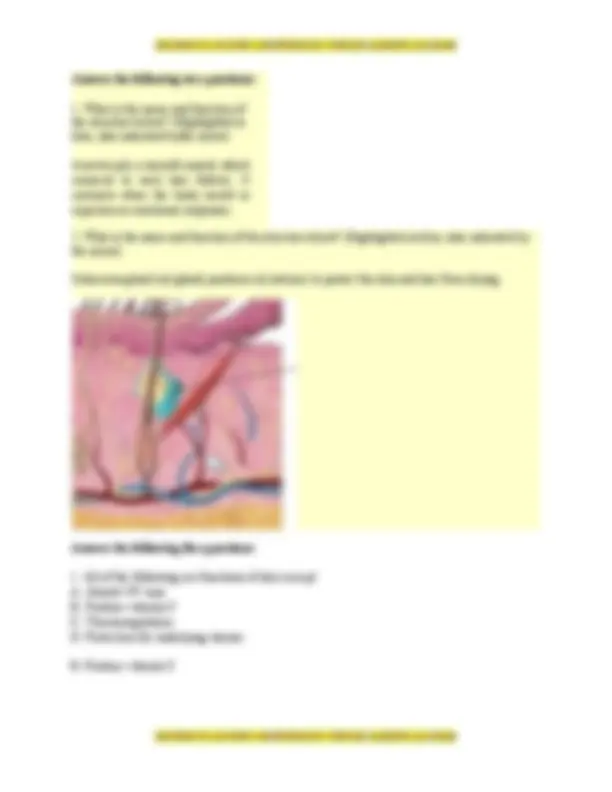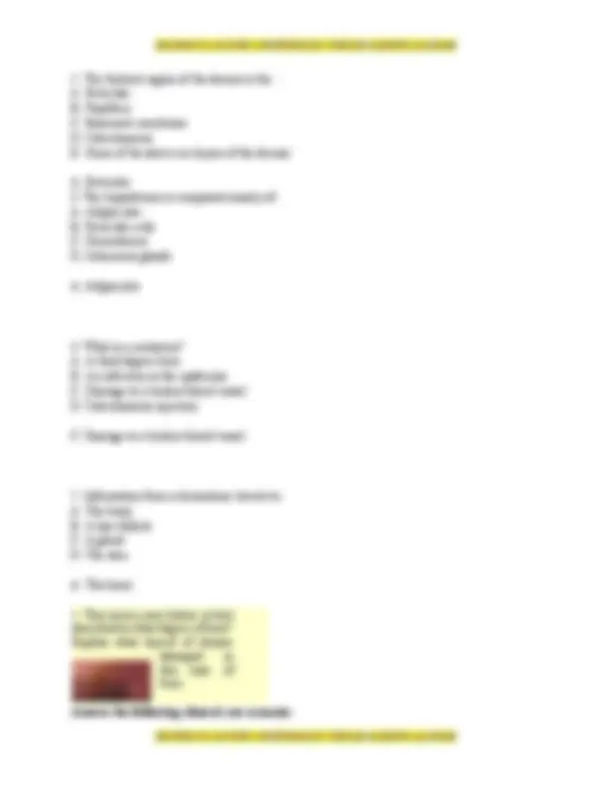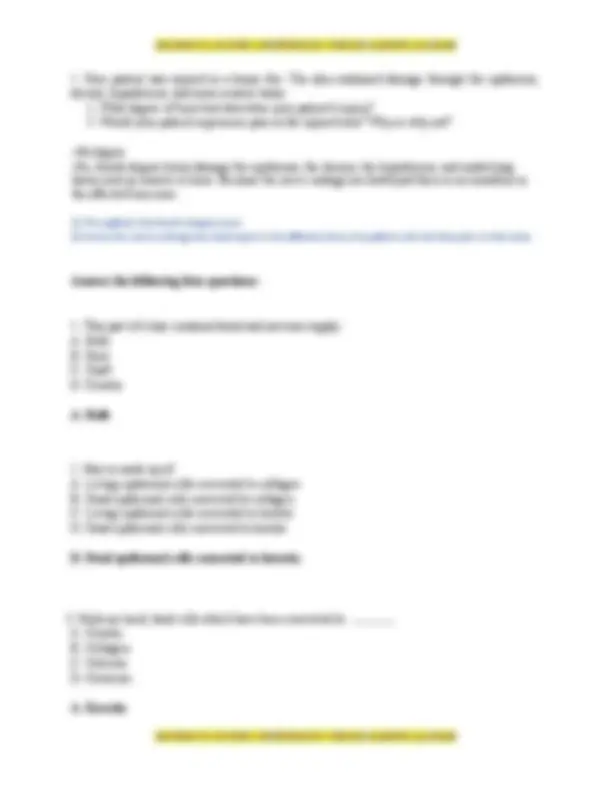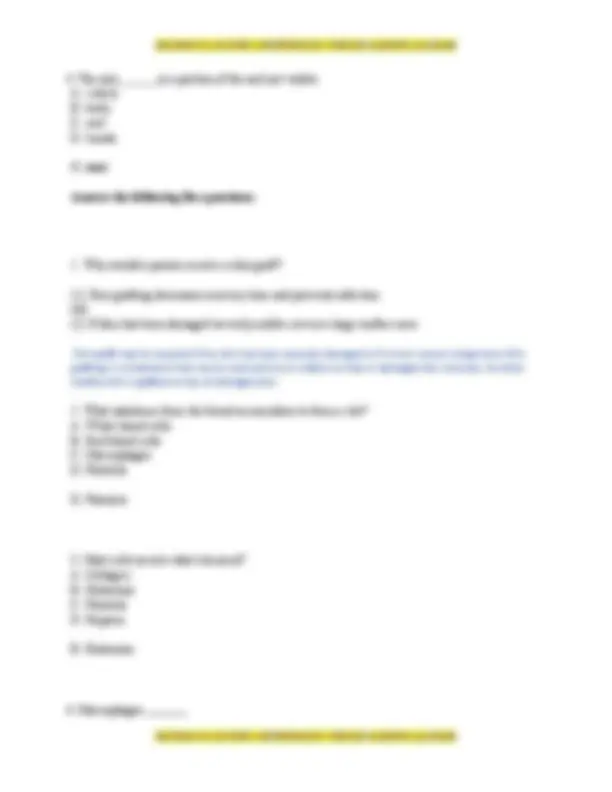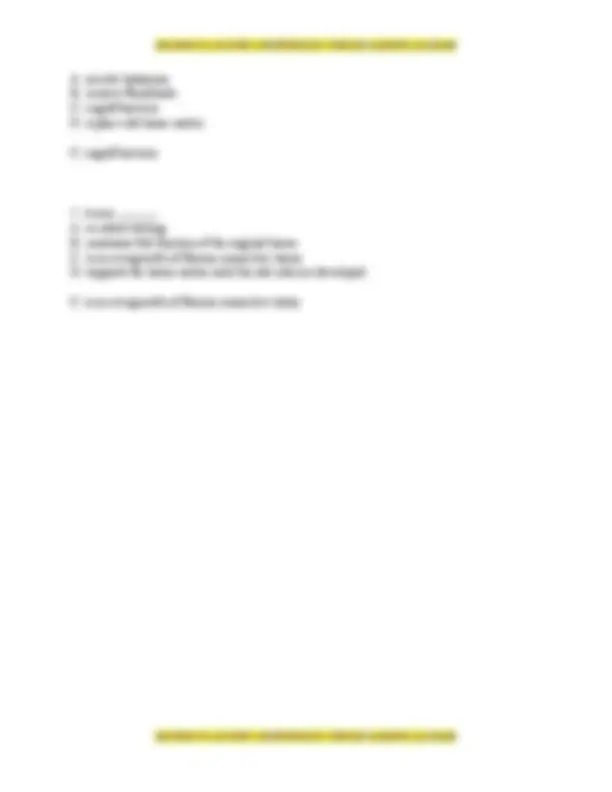Download 2023 BIOD 151 ANATOMY AND PHYSIOLOGY 1 PORTAGE LEARNING and more Exams Animal Anatomy and Physiology in PDF only on Docsity!
2023 BIOD 151 ANATOMY AND PHYSIOLOGY 1 PORTAGE
LEARNING ALL EXAMS.pdf 100% COMPLETE .GRADED A+
D. Catabolism
- List the four basic types of tissues.
Epithelium, muscle, connective, and nervous tissue
- List the three layers of the skin in order from deep to superficial. The deepest layer of the skin should be at the top of your list. To receive credit the layers must be in this order.
- What anatomical orientation term is used to indicate "further from the origin of the body part"? Distal
- You are looking at a diagram of a patient standing in anatomical position. On the sheet of paper containing the diagram, which thumb points to the left side of the paper, right or left? Right Note: Essay answers must clearly be in your own words. All multiple choice questions have one answer unless otherwise specified. Choose the best response to the question with the information provided.
- Are the arms part of the axial or appendicular region of the body? Appendicular
- A patient is standing in anatomical position. The patient moves his hand to scratch his nose. What anatomical action term is best used to indicate the motion occurring at his elbow? A. Flexion B. Extension C. Elevation D. Depression E. Abduction A. Flexion (“closing of a joint”)
- What anatomical action term is used to indicate "movement away from midline"? A. Flexion B. Extension C. Elevation D. Depression E. Abduction E. Abduction
The pelvic cavity contains the bladder, reproductive organs and the rectum
- True or False: The ventral body cavity contains the cranial cavity, the thoracic cavity, and the abdominal cavity. If your answer is false, rephrase the statement to make it a true statement. False. The ventral cavity contains the thoracic cavity and the abdominal cavity. (It does not contain the cranial cavity) Note: Essay answers must clearly be in your own words. All multiple choice questions haveone answer unless otherwise specified. Choose the best response to the question with the information provided.
- The body is divided into anterior and posterior sections by what type of plane? Frontal (coronal) Note: Essay answers must clearly be in your own words. All multiple choice questions have one answer unless otherwise specified. Choose the best response to the question with the information provided.
- Using the letters given, match the cell with the type of solution it has been placed in: A cell beginning to swell A. Isotonic A red blood cell placed in ocean water B. Hypertonic A cell containing an equal amount of solute as the solution C. Hypotonic C. A cell beginning to swell B. A red blood cell placed in ocean water A. A cell containing an equal amount of solute as the solution
- Using the letters given, match each molecule/item with its typical means of entering a cell. You will need to use some means of entry more than once. Oxygen A. Diffusion Lipid-soluble molecules B. Facilitated diffusion Bacteria C. Endocytosis Polar molecules A. Oxygen A. Lipid-soluble molecules C. Bacteria B. Polar molecules
- Which one of the following is not true of active transport? A. Active transport occurs against the concentration gradient B. Carrier proteins move particles from greater concentration to lesser C. The sodium-potassium pump is an example D. additional energy is required to drive this process B. Carrier proteins move particles from greater concentration to lesser
- List the three organelles, in order, involved in the synthesis, transport and shipping of proteins. A. rough ER, Golgi complex, lysosomes B. ribosomes, rough ER, Golgi complex C. ribosomes, smooth ER, Golgi complex D. rough ER, Golgi complex, vacuole **B. ribosomes, rough ER, Golgi complex Note: Essay answers must clearly be in your own words. All multiple choice questions have one answer unless otherwise specified. Choose the best response to the question with the information provided.
- Label the 5 organelles listed below:**
2. True or False? a. The purpose of cellular respiration is to produce ADP. (T or F) b. Peripheral proteins are found on the outer surface of a cell membrane. (T or F) c. Exocytosis is the process that occurs to bring biomacromolecules inside the cell. (T or F) d. Receptor-mediated endocytosis uses a signaling molecule from another cell, binding to the cell membrane to bring about changes within the cell proteins. (T or F) e. Endocytosis is a passive process. It does not require cellular energy expenditure.(T or F) a. FALSE (ATP is produced, not ADP) b. TRUE (Peripheral proteins can be found on the outer or inner surface, but do not span across the entire membrane). c. FALSE (This process is called endocytosis) d. TRUE e. FALSE (Endocytosis is an active process and requires cellular energy) Note: Essay answers must clearly be in your own words. All multiple choice questions have one answer unless otherwise specified. Choose the best response to the question with the information provided.
- In your own words, discuss Tay-Sachs disease. What organelle within the cell is impacted? What are the symptoms of the disease and why do they occur? (1) Lysosomes (2) buildup of toxic lipids inside the cell (biomacromolecules) (3) disability and death In the genetic disease known as Tay-Sachs, one of the normally present digestive enzymes inside lysosomes is lacking. Thus, a toxic lipid in the brain cells cannot be broken down. The resulting buildup of lipids in these cells can cause intellectual disability and death.
- You are observing two cells under the microscope. They are the same type of eukaryotic cell but one appears much larger. Based on appearance alone, which one would you expect to be carrying out respiration at a more active rate, the larger or smaller cell? Explain why.
The smaller cell. Cells need to remain relatively small because as a cell expands the amount of surface area relative to the volume of the cell decreases. The smaller cell is more active because relative to its volume, its surface area is larger than a bigger cell. With a larger surface area (relative to its volume) this allows the metabolic processes to occur faster.
Module 2
Note: Essay answers must clearly be in your own words. All multiple choice questions have one answer unless otherwise specified. Choose the best response to the question with the information provided.
- How many lobes does the right human lung have? Three Lobes
- Air (and not food) pass in which of the following areas: A. Esophagus B. Nasopharynx C. Oropharynx D. Both A. and C. B. Nasopharynx
- Rings of cartilage line much of the respiratory tract. In which of one the following would cartilage NOT be found? A. Trachea B. Larynx C. Bronchi D. Alveoli D. Alveoli Label the following five items from the diagram:
The upward movement of the soft palate prevents food or liquid from entering the nasal passages during swallowing.
- Explain at least two differences between Type I and Type II alveolar cells. a. Type I form the very thin simple squamous epithelium of the alveoli in junction with capillaries. Make up roughly 95% of alveolar epithelial cells. b. Type II produce and secrete pulmonary surfactant which is needed throughout the alveolar surface to keep the alveoli open. In addition, Type II cells can divide to replace damaged Type I cells. Make up roughly 5% of alveolar epithelial cells. Answer the following five true or false questions:
- Negative pressure is used to move air into the lungs. True
- During exhalation the diaphragm contracts to actively push air out of the lungs. False (during inhalation)
- During inhalation the rib cage lifts in an upward motion to open and expand the lungs. True
- As the thoracic cavity expands and lung volume increases, the density of the gases filling the lungs decreases. True
- When the diaphragm rises, thoracic pressure increases and air naturally flows out of the lungs.
True (air naturally flows out of the lungs because of the pressure difference) Answer the following five multiple choice questions:
- Boyle's law states that gas volume is A. Directly proportional to temperature B. Inversely proportional to temperature C. Directly proportional to pressure D. Inversely proportional to pressure E. Both A and B D. Inversely proportional to pressure
- Typical respiratory epithelium contains all of the following, except which one? A. cilia B. layers C. tall, narrow cells D. mucus producing cells E. goblet cells B. layers
- Which cells are most abundant within the alveoli? A. Macrophages B. Type 1 alveolar cells C. Type 2 alveolar cells D. Erythrocytes E. Ciliated columnar cells A. Macrophages
- Which one of the following is not true of the respiratory physiology? A. Tidal volume is the maximum amount of air able to be inhaled beyond normal inhalation B. Tidal volume is the amount of air inhaled and exhaled in one cycle of quiet breathing C. Inspiratory reserve volume is the maximum amount of air able to be inhaled beyond normal inhalation
- The bronchioles are surrounded by capillaries for gas exchange. **False Matching: A. Emphysema B. Cystic Fibrosis C. Pulmonary edema D. Pleurisy The pleural space fills with air, pus or blood. D. Pleurisy This condition results from fluid-filled alveoli. C. Pulmonary edema This condition results in a loss of alveoli. A. Emphysema This hereditary illness results in excess mucus. B. Cystic Fibrosis Answer the following three questions:
- The pressure of three gases equals 1 atmosphere. What is the partial pressure of oxygen (in mmHG) if nitrogen is 300 mmHg and carbon dioxide is 350 mmHg? To receive full credit you must show your work. 110 mmHG 1atm= 760 mmHg 300 mmHg + 350 mmHG + X = 760 mmHg OR: 760 - 300 - 350= 110 mmHG**
**2. Why would warming air be beneficial to gas exchange? It would expand the air to make it more available for gas exchange.
- Explain why incomplete ventilation is important for effective gas exchange. Incomplete ventilation helps to maintain a constant temperature within the lungs. The increased temperature allows for greater gas exchange. Answer the following three questions:**
- From widest to narrowest, the branches of the bronchial tree are: A. Secondary bronchi, tertiary bronchi, primary bronchi, bronchioles B. Bronchioles, primary bronchi, secondary bronchi, tertiary bronchi C. Tertiary bronchi, secondary bronchi, primary bronchi, bronchioles D. Primary bronchi, secondary bronchi, tertiary bronchi, bronchioles D. Primary bronchi, secondary bronchi, tertiary bronchi, bronchioles
- In gas exchange (external respiration): A. Carbon dioxide diffuses from alveoli into capillaries, oxygen diffuses from capillaries into alveoli B. Oxygen and carbon dioxide is carried from alveoli into the bronchioles C. Oxygen diffuses from alveoli into capillaries, carbon dioxide diffuses from capillaries into alveoli D. Oxygen is chemically transformed into carbon dioxide within the alveoli C. Oxygen diffuses from alveoli into capillaries, carbon dioxide diffuses from capillaries into alveoli
- The purpose of alveolar macrophages is to: A. Produce a lipoprotein B. Form a thin, simple squamous epithelium of the alveoli C. Produce mucous in order to trap bacteria D. Act as the primary immune defense within the alveoli

